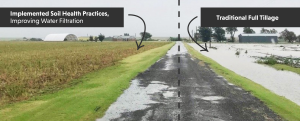Many farmers share common ground that soil health matters, but the topic of soil health can often lead to many other questions.
- What defines healthy soil?
- How can I improve the health of my soil?
- Do cover crops really help the sustainability of my soil?
- What resources are available to help me continue to improve my soil?
These are all very good questions.
What Defines Healthy Soil
Let’s start with the basics – what defines healthy soil? Soil health can be defined in a variety of ways, including: a vital living ecosystem, soil quality, biodiversity, nutrient cycling, and more. When you achieve healthier soil, it can lead to higher productivity on your farm and a higher overall ROI.
Keys to Improving Soil Health
- Minimize disturbance and reduce tillage.
- Plant diverse cover crops.
- Improve water infiltration.
- Utilize waterways to help control water flow.
- Increase soil organic matter.
Cover Crops and Sustainability for Soil
One thing that can help “cover” many of the soil health definitions listed above is the integration of cover crops. The introduction of cover crops will provide many benefits to the soil health in your fields.
- Cover crops can help with better water infiltration through the soil profile.
- Having a mixture of cover crops will help add diversity to your soil, generating a variety of beneficial microorganisms.
- Utilizing various cover crop species will provide better nutrient cycling in the soil, making nutrients readily available to the cash crop.
- Using cover crops correctly can quickly increase soil health on your farm and improve your ROI.
We have all seen a picture that’s worth a thousand words. This picture tells the story of two different farming practices.

- The field on the right is what’s considered to be conventional farming: full tillage and a growing crop for only a few months out of the year. A field in this typical full tillage practice can handle roughly half an inch of rainfall per hour.
- The field to the left has adopted some conservation practices, like no-till and cover crops. By adding a growing crop year-round and reducing tillage, we can increase the water holding capacity of the soil. Fields like the one on the left have the capability of handling 2-4 inches of rainfall per hour. Doing this will keep our soil intact and out of our streams.
Additional Resources for Soil Health
Have questions on soil health or cover crop options best suited for your farm? Talk to your local Mercer Landmark Crop Production Advisor or Conservation Agronomist.
You can also view more soil health tips at soilhealthpartnership.com or https://www.farmers.gov/conservation/soil-health.
